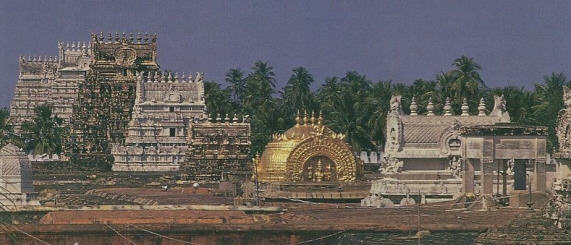
The history of this holy place traces back to the beginning of creation.
SRI RANGAM, or Sri Rangaksetra, is the largest temple in the world in which worship is still being performed. Situated on an island at the confluence of the Kaveri and Kollidam rivers in the South Indian state of Tamil Nadu, Sri Rangam is the main center of worship and culture for the Sri Vaisnavas, the disciplic line of devotees of Lord Visnu (Krsna) that begins with Laksmi Devi (Sri, Lord Visnu's consort). Historically, their main acarya, or spiritual teacher, was Sri Ramanuja (See sidebar, page 31).
The Sri Rangam temple compound covers about three square miles. The main temple is surrounded by seven walls, which represent the seven planetary systems described in Vedic cosmology. The seven walls have twenty-one towered entrances (gopurams), the highest of which, at 250 feet, can be seen from at least ten miles away. Much of the town of Sri Rangam is within the three outer walls of the temple compound.
The Deity in the main temple is Sri Ranganatha Swami, a two-armed form of Lord Visnu reclining on the divine serpent Ananta Sesa. The priests of Sri Rangam have worshiped Sri Ranganatha in much the same way since the eleventh century, when Sri Ramanuja set up strict standards of worship, with a meticulous schedule of songs, prayers, rituals, and offerings.
Since the time Sri Ranganatha decided to stay at Sri Rangam (See sidebar "Sri Rangam: The History, page 29) countless kings, queens, saints, sages, devotees, demigods, and goddesses have eagerly stood before the doors of His chamber awaiting His merciful glance. Millions of souls since ancient times have had that fortune, and many more will have it for many years to come.
Bhakti Vikasa Swami comes from England but has lived in India for many years. He now teaches Krsna consciousness at the ISKCON center in Baroda, Gujarat.
Jaya Vijaya Dasa has been a leader of ISKCON's India Padayatra since it began in 1984.
The Brahmanas of Sri Rangam
AN OLD brahmana struggles to climb the stairs to perform his service in the temple. I ask him when he is going to retire.
"No, the Lord wants our surrender," he replies. "The Lord does not want our surrender up to one week or three weeks before our death. He wants our lifelong surrender."
I have met many Sri Rangam brahmanas, and they are very special people. They have very great feeling for Sri Ranganatha Swami and Sri Ramanuja. They will not give up their service. "What would Ramanuja think?" they say.
I have met brahmanas who have been worshiping Sri Ranganatha Swami all their lives. They will not miss a day, even when sick. If they have a high fever and are too sick to bathe, they will stand near the Deity's chamber and direct someone else on how to perform a particular service for the Lord.
Many Sri Rangam brahmanas who by circumstance have to live elsewhere, even outside India, carry with them their great devotion to Sri Ranganatha Swami.
(Bhakti Vikasa Swami)
Sri Rangam: The History
THE HISTORY of Sri Rangam, as told in various Puranas and other Vedic writings, traces back to the beginning of creation. Pleased by the penance of Brahma (the first created being), Lord Visnu (the Supreme Lord) manifested Himself in the form of Lord Ranganatha for Brahma to worship. Lord Ranganatha appeared with His Deity chamber, or vimana.Brahma worshiped Lord Ranganatha for a long time and eventually handed the worship over to Vivasvan, the sun-god, who handed it over to Svayambhuva Manu, the father of mankind. Manu passed on the worship to his son Iksvaku, a great king and the head of the dynasty in which Lord Krsna was later to appear in His incarnation as Lord Ramacandra.
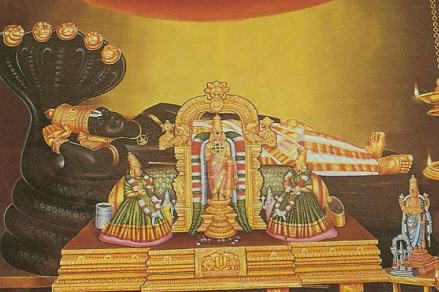
Lord Ramacandra ruled in Ayodhya, in northern India, during the age known as Treta-yuga, millions of years ago. The pastimes of Lord Ramacandra are recounted in the epic Ramayana. Lord Ramacandra defeated the great demon Ravana, who had kidnapped the Lord's wife, and placed Ravana's brother Vibhisana on the throne of Sri Lanka, Ravana's former kingdom. Because Vibhisana was a great devotee, Lord Ramacandra presented Him with the Deity of Sri Ranganatha to worship in Sri Lanka, off the southeast coast of India.
While traveling to Sri Lanka with Sri Ranganatha (along with the Lord's vimana), Vibhisana stopped near the Kaveri River, at a holy place called Candra Puskarini, where a Deity of Ananta Sesa (the Lord's serpent-bed) was worshiped. Dharma Varma, a king of that region, had seen Lord Ranganatha in Ayodhya and had been praying for some time to be able to serve Him. Lord Ranganatha blessed the king by promising to stay at Sri Rangam. When Vibhisana tried to continue his journey, Lord Ranganatha would not move.
Lord Ranganatha then blessed Vibhisana by promising to always look toward Vibhisana's kingdom, Sri Lanka. So although most Deities in India face east, Sri Ranganatha Swami reclines on His right side with His head toward the west as He looks south toward His great devotee Vibhisana.
King Dharma Varma and his successors in the Chola dynasty built a large temple around the vimana of Lord Ranganatha and served Him with great opulence. But after many generations the temple was covered in sand and gradually lost and forgotten.
Then one day, temple histories say, a king of the Chola dynasty was resting under a tree in the area when a parrot told him that Lord Ranganatha was buried under the sand. The king then excavated the temple and restored all parts of the huge complex. Over the years to follow, numerous Chola and Pandya kings, including King Kulasekhara (See sidebar, page 36), expanded and renovated the temple.
Great Vaisnava leaders Yamunacarya, Ramanujacarya, and Sudarsanacarya all had important roles in the further development of Sri Rangam. But during the fourteenth century invading Moghuls plundered most of the Lord's treasures. Then in the fifteenth and sixteenth centuries the Vijayanagar and Nayak rulers slowly began to revive the glories of Sri Rangam. In the seventeenth and eighteenth centuries Muslims, the French, and finally the British used the fort-like temple of Sri Rangam during their conquests. Eventually, when India gained independence in 1947, the Indian government and the Sri Vaisnavas took over the management of the temple.
Sri Ramanuja
SRI RAMANUJA (A.D. 1017-1137) spent 80 of his 120 years at Sri Rangam. For twenty years he was the chief priest of the temple.
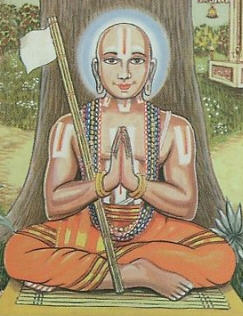
Ramanuja is the main acarya, or spiritual teacher, in the line of teachers and disciples knows as the Sri Sampradaya. His presentation of Krsna consciousness is known as visistadvaita, "qualified nondualism." A staunch proponent of the philosophy of personalism, he taught that although the Supreme Lord and the individual souls are qualitatively one, there is still a difference between them, for the Lord is infinite and the living entities are infinitesimal. Ramanuja traveled extensively throughout India, teaching personalism and debating proponents of monistic philosophy. His commentary on the Vedanta-sutra is known as Sri-bhasya.
Ramanuja founded seventy-four centers of Sri Vaisnavaism and initiated seven hundred sannyasis (renunciants), twelve thousand brahmacaris (celibate students), thousands of householders (including kings and wealthy landowners), and three hundredketti-ammanis, women who took vows of renunciation.
Here are some of Sri Ramanuja's instructions as he was about to leave this world:
"Worship all Vaisnavas as you worship your guru. … Have faith in the previous acaryas. … Study scriptures that describe the glories of the Supreme Lord. … Always endeavor for purity. … Take shelter of the Lord and have faith in Him alone.
"If you follow these instructions, you will never be separated from me. Why should one grieve over the disappearance of the temporary body?"
Because the body of a great devotee is considered spiritual, Ramanuja's followers preserved his body after he passed away. Over the years the priests of Sri Rangam have regularly applied a special preservative, and after more than 850 years Ramanuja's body has not decayed. It is worshiped in a temple within the Sri Rangam compound. Sri Ramanuja sits in the lotus position, his right hand extended slightly forward, bestowing benedictions.
Appreciating the Residents of Sri Rangam
THOSE WHO LIVE and die in Sri Rangam, as in any holy place, are rare, fortunate souls. Somehow or other they have a special internal relationship with the Lord, which may be much deeper than we can see. Visitors should always give the local residents of any spiritual place the utmost respect.
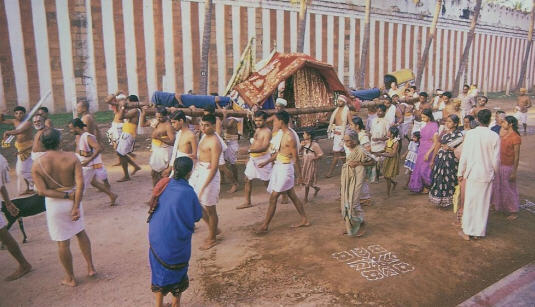
In the course of Padayatra, our walking tour of India, we come in touch with hundreds of thousands of people, but when we enter a holy place we try to view everything with a different consciousness. We have entered a spiritual zone , where the Lord and His associates enact numerous pastimes. If we offer respect with care, reverence, and sincerity, the Lord may allow us some understanding of His pastimes here.
Though we have visited many places, only in Sri Rangam have I seen such great respect toward Lord Caitanya and kindness toward His devotees. Only in Sri Rangam have I seen brahmanas offer full prostrated obeisances to the Padayatra Deities as we chanted in procession around the temple precincts. And only in Sri Rangam have I heard the priests serving Sri Ranganatha stop the rushing queue so "the Hare Krsnas can have an extra long darsana [audience] of the most merciful Sri Ranganatha Swami."
One evening in the temple of Sri Ranganayaki Nachiyar (Maha-Laksmi, Lord Ranganatha's consort), we met an eighty-five-year-old Sri Vaisnava who could barely walk and see. Still, despite his advanced age and physical difficulties, he was coming to the temple. He looked up at us, surprised to see foreign devotees.
"How are you?" I asked him.
"Very fine!" he replied in a clear voice.
He then chanted various mantras glorifying the Lord. He loudly chanted "Govinda!" full of youthful enthusiasm, and he raised his hands and danced.
The next evening I met him again and asked how he was doing.
"I'm very happy, very happy!" he said.
Such happiness is the potency of the holy names of the Lord chanted by one of His devotees in the holy places of Sri Rangam.
(Jaya Vijaya Dasa)
Lord Caitanya's Visit to Sri Rangam
LORD KRSNA appeared five hundred years ago in West Bengal as Sri Caitanya Mahaprabhu, who accepted the mood of a devotee of Krsna. After taking sannyasa, the renounced order of life, Lord Caitanya traveled throughout India for six years, visiting holy places and spreading the chanting of the holy names of the Lord. During that period, the longest time He spent in one place was at Sri Rangam.
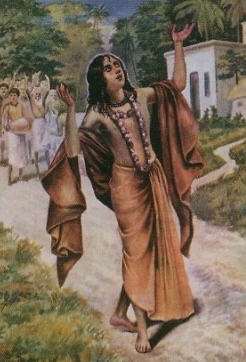
Lord Caitanya observed the practice that a sannyasi ceases travel during the four months of the rainy season. So one year He spent those four months in Sri Rangam, at the home of a Sri Vaisnava brahmana named Vyenkata Bhatta. Because Vyenkata Bhatta was a devotee with whom Lord Caitanya could discuss the transcendental pastimes of Lord Krsna, Lord Caitanya passed His days at Sri Rangam in great happiness.
Lord Caitanya would bathe daily in the sacred Kaveri River and visit the temple to see Sri Ranganatha Swami. Many hundreds of thousands of people from various parts of India came to Sri Rangam to see the beauty of Caitanya Mahaprabhu and His ecstatic love for Lord Krsna. Every day, local Vaisnava brahmanas would invite Caitanya Mahaprabhu to their homes for lunch.
Vyenkata Bhatta and Caitanya Mahaprabhu developed a friendly relationship, and they would happily laugh and joke together. Since Vyenkata Bhatta belonged to the Sri Sampradaya and worshiped the Supreme Lord in His majestic aspect as Laksmi-Narayana, Caitanya Mahaprabhu would have lengthy spiritual discussions with him about the differences between worshiping Laksmi-Narayana and worshiping the Lord in His most sweet form as Radha-Krsna. To establish that the worship of Radha-Krsna is higher than that of Laksmi-Narayana, Lord Caitanya (all the while in a pleasant mood) cited a scriptural reference that tells how Laksmi, the consort of Narayana, wanted to join the most confidential pastimes of Krsna but was not allowed to do so.
Unable to defeat Lord Caitanya's arguments, Vyenkata Bhatta said, "You are the Supreme Personality of Godhead Krsna Himself. You know the purpose of Your activities, and the person whom You enlighten can also understand Your pastimes."
Caitanya Mahaprabhu enlightened Vyenkata Bhatta in all the subtle details of Lord Krsna's most intimate pastimes.
Lord Caitanya then said, "There is no difference between the transcendental forms of the Lord. Different forms are manifested due to different attachments of different devotees. Actually the Lord is one, but He appears in different forms just to satisfy His devotees."
When the four-month period ended, Sri Caitanya Mahaprabhu took permission from Vyenkata Bhatta to continue on with His travels. When Caitanya Mahaprabhu bade farewell, Vyenkata Bhatta fell down unconscious in the ecstasy of spiritual love.
Pilgrims to Sri Rangam can still visit the house of Vyenkata Bhatta.
The Prayers of King Kulasekhara
KING KULASEKHARA, who scholars say may have lived during the ninth century, was one of the twelve Alvars, ecstatic mystic poets who appeared in South India at various times between one thousand and five thousand years ago. The Alvars wrote mostly in the South Indian language Tamil. The Sri Vaisnavas accept the poems of the Alvars as scripture.*
*One reason for Sri Rangam's prominence is that it is the only divya-desam glorified by all twelve Alvars. The Sri Vaisnavas list 108 divya-desams, "holy sites," of which Sri Rangam is the chief. In Tamil it is referred to as Periya Koil, "the temple of temples."
King Kulasekhara was the tenth Alvar. After giving up the throne, he resided at Sri Rangam, where he wrote two great works: Mukunda-mala-stotra*, in Sanskrit, and a collection of 105 Tamil hymns.
*Available in English from the Bhaktivedanta Book Trust (BBT). The translations of the prayers given here are from the BBT edition.
The following prayers are from the Mukunda-mala-stotra:
jayatu jayatu devo devaki-nandano 'yam
jayatu jayatu krsno vrsni-vamsa-pradipah
jayatu jayatu megha-syamalah komalango
jayatu jayatu prthvi-bhara-naso mukundah
All glories to this Personality of Godhead known as the son of Srimati Devakidevi! All glories to Lord Sri Krsna, the brilliant light of the Vrsni dynasty! All glories to the Personality of Godhead, the hue of whose soft body resembles the blackish color of a new cloud! All glories to Lord Mukunda, who removes the burdens of the earth!
mukunda murdhna pranipatya yace
bhavantam ekantam iyantam artham
avismrtis tvac-caranaravinde
bhave bhave me 'stu bhavat-prasadat
O Lord Mukunda! I bow down my head to Your Lordship and respectfully ask You to fulfill this one desire of mine: that in each of my future births I will, by Your Lordship's mercy, always remember and never forget Your lotus feet.
maj-janmanah phalam idam madhu-kaitabhare
mat-prarthaniya-mad-anugraha esa eva
tvad-bhrtya-bhrtya-paricaraka-bhrtya-bhrtya-
bhrtyasya bhrtya iti mam smara loka-natha
O enemy of Madhu and Kaitabha, O Lord of the universe, the perfection of my life and the most cherished mercy You could show me would be for You to consider me the servant of the servant of the servant of the servant of the servant of the servant of Your servant.
krsna tvadiya-pada-pankaja-panjarantam
adyaiva me vasatu manasa-raja-hamsah
prana-prayana-samaye kapha-vata-pittaih
kanthavarodhana-vidhau smaranam kutas te
O Lord Krsna, at this moment let the royal swan of my mind enter the tangled stems of the lotus of Your feet. How will it be possible for me to remember You at the time of death, when my throat will be choked up with mucus, bile, and air?
Srila Prabhupada was very fond of this prayer, and he would sing and quote it often.
Visiting Sri Rangam
How to get there Sri Rangam is ten kilometers from Tiruchirapalli (also called Trichy), a prominent city in Tamil Nadu you can reach by air, rail, or road. You can take a taxi or a city bus from Trichy to Sri Rangam.
Lodging There are no hotels in Sri Rangam, but Trichy has a good selection.
Festivals There's a good chance you'll see one when you visit festivals are held on 250 days each year.
ISKCON center Be sure to visit the ISKCON center in Sri Rangam. The address: 6A E.V.S. Rd., Sri Rangam.Phone: 433945.
